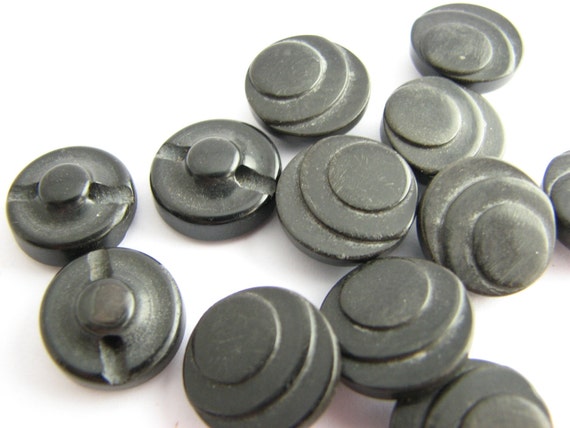 |
| Vegetable ivory buttons can be carved and dyed into small pieces of art! |
Vegetable ivory buttons can have any colour, more or less vivid, painted like those above, or dyed. They can also be carved and even embossed with subtle or a bit more pronounced pattern or texture. Their natural colour is off white, just like the authentic ivory.
 |
| These tagua nut buttons are quite small but you can see the embossed texture. |
How to identify Tagua nut buttons
There are a few things that are very characteristic about these buttons. The basic rule is that vegetable ivory is such a dense material that it does not let the dye sink in beyond the first layer. So to start with, we have to look closely at the back of the buttons. Normally, vegetable ivory buttons are dyed before drilling the holes, which means, that we will be able to see the natural off-white colour of the nut somewhere. Like here: |
| See the line across the back of the button? This green tagua nut button had the hole drilled after it was dyed. |
However, some buttons were dyed after the details were finished. I have a few examples like that here. But there are other features that clearly indicate what these buttons are made of.
 |
| These buttons were dyed after the holes were drilled. But we can easily see the grain. |
If you take a vegetable ivory button in your hand, it resembles a wooden button, only that it is much higher density, and so, a bit heavier. Wood can be easily damaged with a finger nail by simply pressing, whereas vegetable ivory will remain untouched.
The surface of tagua nut button can be polished so that it resembles the real ivory, or left a bit unpolished and rough.
Another characteristic feature is the fine grain on the surface. This is different from wooden buttons, and very difficult to achieve in plastic buttons (although nowadays plastic can imitate anything...). Apart from that, many corosso buttons, especially those cheaper, plain ones, meant generally for menswear, may preserve a bit of the tagua nut hull - the "bark" of the nuts, which looks like this:
This "bark" can even be incorporated in the button design, as was the case of this very original button:
How to handle the buttons
Vegetable ivory buttons are usually durable and do not need any special care. I would not wash them in a washing machine, however, just in case, as some of the dye may not be that durable and could ruin other garments. I had some buttons that bled when rubbed with damp cloth. If they are not dyed, they can stand machine-washing pretty well. |
| Playing with the tagua nut natural colour. I am sure these would not bleed. |
Tagua nut buttons were especially popular in the 1920s and 1930s, and still produced until 1950s. It is a shame we turned to plastic so definitely, as these little pieces were really a sustainable and beautiful alternative.
Last but not least, I have a very rare piece, which is a vegetable ivory buckle! It is not very big, as tagua nuts rarely allow carving larger pieces (though I did have a few big pieces among my buttons). This buckle was very characteristically dyed and then carved.
___________________________________________
This post has been updated several times, as I get more and more interesting pieces.




No comments:
Post a Comment